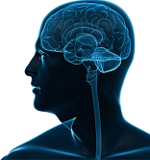Visual Dysfunctions following Concussion and other Traumatic Brain Injuries
Recent literature has highlighted the prevalence of dysfunctions in vision following traumatic brain injuries of all levels of severity (including concussion.) Research published by the Veterans Administration (VA) in 2012 indicates that the percentage of TBI victims with vision problems could be as high as 60%. They explain that this prevalence is not surprising, since over 50% of the brain is involved in visual processing. Alvarez et. al. explain how visual and other symptoms occur when the brain is subjected to “acceleration/deceleration” forces:
TBI may be associated with diffuse axonal injury (DAI), which may occur with or without a focal blunt force to the head.28, 29 Trauma of acceleration / deceleration may lead to damage to the white matter and superficial layers of the brain. This damage may then extend inward within the brain, depending upon the extent of acceleration / deceleration forces. Initially, the injury disrupts the cytoskeletal network and axonal membranes of white matter and the surrounding cerebral vasculature.30–33 Secondary damage may occur due to ischemia and a cytotoxic cascade, including altered calcium homeostasis and oxygen depletion, leading to cell death.30–33The recovery from TBI may be determined by the severity of these secondary injuries.32, 33 Some brain regions may be more at risk for mechanical injury during trauma than others.34 Given the presumed diffuse damage of TBI, it is not surprising that TBI manifests in a diverse array of motor, sensory, cognitive and / or emotional symptoms and disabilities, both short and long-term.
One of the more common vision problems after traumatic brain injury is “convergence insufficiency.” Convergence is the simultaneous inward movement of both eyes toward each other, usually in an effort to maintain single binocular vision when viewing an object. It is part of the near-vision complex of the brain and depends on the integrative function of the cortical and subcortical areas, which is often compromised by traumatic brain injury.
As the VA research report notes, patients with convergence insufficiency report an array of vision challenges, including blurred vision, diplopia (double vision), eye strain, headaches, loss of concentration, having to read and/or reread slowly, difficulty in remembering what was read and visual fatigue. Needless to say these symptoms may adversely affect daily activities such as schoolwork and employment tasks, as well as the overall quality of life. They can also lead to inadequate progress in other rehabilitative services, such as cognitive therapy.
Another very common vision problem following TBI is “photophobia” (heightened sensitivity to bright light.) This can also lead to other symptoms including headaches, eye strain and fatigue and can severely limit day-to-day functioning.
There is good news concerning treatment of vision issues following TBI, especially convergence insufficiency. The January 2014 issue of NeuroRehabilitation reported the findings of Thiagarajan et. al. that ocular-motor based vision rehabilitation had a strong positive effect on oculomotor control, reading rate and overall reading ability. This ocular motor learning effect suggests considerable residual neuroplasticity and good potential for improvement of these symptoms. Treatment for photophobia remains less clear.
TBI victims who experience any of the symptoms associated with vision defects are encouraged to seek assessment and treatment.

